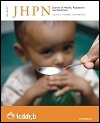Malnutrition among 3 to 5 Years Old Children in Baghdad City, Iraq: A Cross-sectional Study
DOI:
https://doi.org/10.3329/jhpn.v31i3.16827Keywords:
Children, Insecure living environment, Underweight, IraqAbstract
The unstable geopolitical situation in Iraq since 2003 still affects the health of people, especially children. Several factors may indirectly affect a childs nutritional status. The main aim of this study was to identify factors contributing to malnutrition among 3 to 5 years old children in Baghdad city, Iraq. Two hundred twenty children aged 3 to 5 years were chosen randomly from four kindergartens in Baghdad city according to the cross-sectional design. The nutritional status of the children was assessed using a weight-for-age z-score based on the World Health Organization 2007 cutoff points, in which any child with a z-score of <-2 is considered to be malnourished. The overall prevalence rate of underweight children was 18.2%. There was no significant difference in the prevalence rate between males and females (p=0.797). However, the percentage of underweight children was slightly higher among females (18.9%) compared to males (17.6%). There was no association between parents educational level or employment status and childhood malnutrition. There was no association between a familys movement from their house and childhood malnutrition (p=0.322). Living in an unsafe neighbourhood and having a family member killed during the past five years were significantly associated with childhood malnutrition (p=0.016 and 0.018 respectively). Childhood malnutrition is still a public-health concern in Baghdad city, especially after the war of 2003. Malnutrition is significantly associated with living in unsafe neighbourhoods and at least one family member having been killed during the past five years.
DOI: http://dx.doi.org/10.3329/jhpn.v31i3.16827
J HEALTH POPUL NUTR 2013 Sep; 31(3): 350-355
Downloads
432
244

